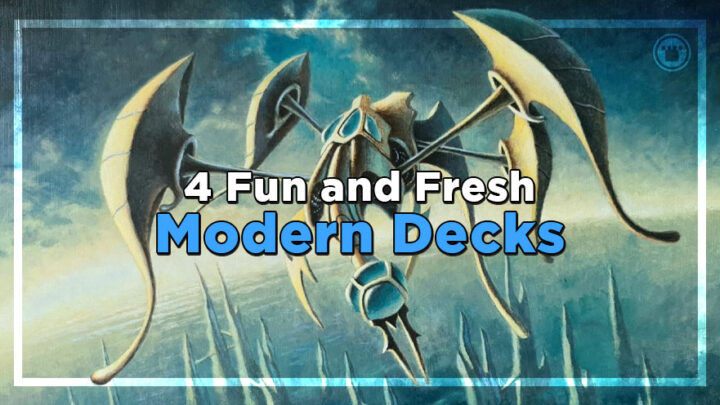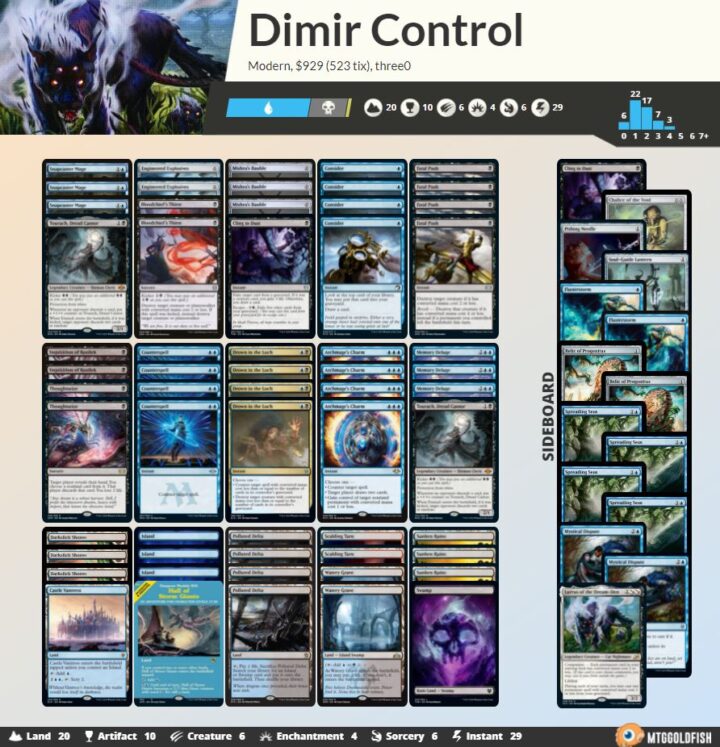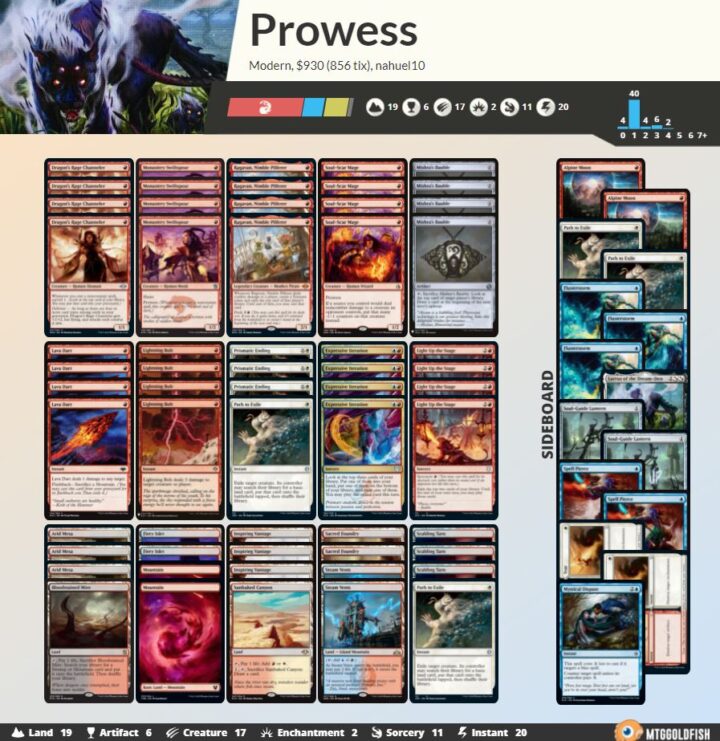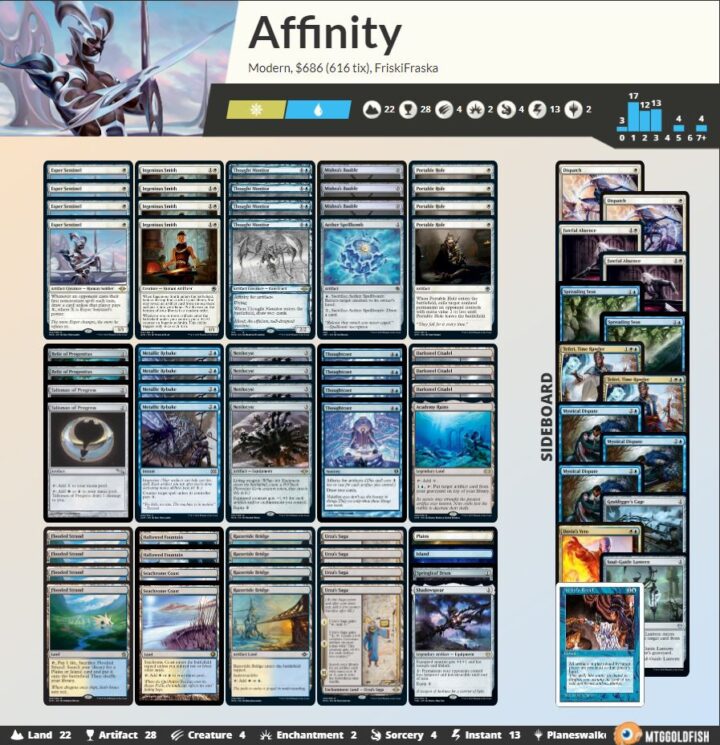Modern is a format full of possibilities, but too often, we see the same cards and decks talked about ad nauseam. Today, we’ll be looking at four decks that have all done well in big events recently that are fun, powerful, and underexplored. It’s all spice all day today, so let’s jump right into it.
Dimir Control
Control decks have always been forced into Teferi’s shadow in Modern. This deck looks to break that mold, while also returning to a more back-to-basics style of control.
You won’t see any planeswalkers taking over the game in this deck. Instead, the plan is to grind your opponent out with two-for-ones in the form of Tourach and Snapcaster Mage. We also get Lurrus, which can recur answers like Engineered Explosives along with impactful creatures like Snapcaster.
Historically, these sort of decks haven’t made an impact in Modern. They didn’t have enough interaction to get out of the early game, and they didn’t have a clear path to victory. Thanks to Lurrus, these decks finally have inevitability, and they never run out of gas. This deck can choose when to start turning the corner, which is a luxury that more traditional Azorius Control decks don’t always have, due to their dependence on planeswalker cards.
If you’re an old-school control player at heart, this is the deck for you.
Jeskai Prowess
This archetype first emerged as a Boros deck, using cheap red creatures and powerful white removal to get around midrange decks like Shadow. This Jeskai build stretches the deck’s mana base a bit, but in exchange, we get a huge power boost in the form of Expressive Iteration.
Expressive Iteration is without a doubt one of the best cards printed into Modern in the last year – and that includes Modern Horizons 2. Iteration allows us to dig for the perfect answer and avoid running out of gas. The blue splash also opens up some powerful sideboard cards like Flusterstorm and Mystical Dispute. Boros Prowess was often weak to decks that avoided playing to the battlefield, so these are some much-needed upgrades.
Unlike previous Prowess decks, this build doesn’t go all-in on the early turns and allows you to play a longer game when you need to. It’s more of an aggressive midrange deck, and it can grind with decks like Shadow. Like Dimir Control, this is also a fairly good Lurrus deck, thanks to its strong threats and card advantage options.
I think the archetype is much better than people give it credit for, and if you’ve been looking for an aggressive-leaning deck that isn’t full of Lava Spikes, this might be the deck for you.
UW Affinity
This deck reminds me a lot of the artifact-based Urza’s Saga decks I covered last week. Instead of Urza’s Saga, it leans on a card-draw engine built around another Modern Horizons 2 standout, Thought Monitor, and Affinity standby Thoughtcast.
Leaning into this tap-out engine build forces the deck to make some interesting concessions. Ingenious Smith is one of those. This card has been popping up from time to time in Hammer decks, and I tried it out in some rough drafts of last week’s decks. Ultimately, I felt like it was too at odds with my plans, but this build can make much better use of it.
This seems like a huge step in the right direction for Affinity. It’s much more proactive than other artifact decks without sacrificing card quality for efficiency. I especially like how quickly this deck can close the door. While it’s a bit more susceptible to hate cards, that’s a line these decks will always have to tread carefully.
Grinding Station
This deck has been on the fringe of the format for a while now. For those unfamiliar, the combo in this deck involves Grinding Station, Mox Amber, Underworld Breach, and a legendary creature. Sacrificing Mox Amber to Grinding Station puts enough cards in your graveyard to pay Underworld Breach’s escape cost, so you can play it from your graveyard until you mill your whole deck. Then, once you’re out of cards in your library, you can play Thassa’s Oracle and win the game.
There are a lot of moving parts, to be sure, but Underworld Breach will help you reassemble any pieces you need from your graveyard when it comes time to combo. And once the combo gets started, it’s hard to stop – your opponent needs very specific answers.
At the end of the day, though, answers for the graveyard and artifacts are plentiful in Modern. That’s why this deck combines its powerful late game combo with a holy trinity of Modern midrange cards: Dragon’s Rage Channeler, Ragavan, and Unholy Heat. These cards allow you to play an Izzet Murktide-style game and pressure your opponent on another angle while you set up your combo.
I’ve already sung Expressive Iteration’s praises today, but I think it’s a great fit for this deck, too. Iteration allows you to quickly assemble the combo or find the cards you need to get out of a tough spot. Combine this with Emry’s ability to recoup combo pieces and the raw card advantage of Mishra’s Bauble, and you’re looking at one of the more resilient “fragile” decks Magic has ever seen.
This may be one of the most underexplored decks in Modern. If you enjoyed playing Splinter Twin-style combo decks with a fair backup plan, I can’t recommend this deck enough.
These four decks are all carving out their own unique place in Modern. Which deck are you most excited to battle with? Tweet at @masoneclark and let me know!

Mason Clark is a grinder in every corner of the game who has played at the pro level and on the SCG Tour with Team Nova. Whether he’s competing in Standard, Historic or Modern, Mason plays with one goal in mind: to be a better player than he was the day before. Check out his podcast, Constructed Criticism, and catch his streams on Twitch.





